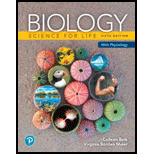
Concept explainers
Add labels to the figure that follows, which illustrates the product and reactants of photosynthesis and the relationship between its light reactions and light-independent reactions.

To label:
The given figure, which illustrates the product and reactants of photosynthesis and the relation between its light reaction and light-independent reactions.
Introduction:
Photosynthesis is a phenomenon that changes solar energy to chemical energy needed by all living organisms. Photosynthesis occurs in chloroplasts that found in the green part mainly in leaves of the plants.
Explanation of Solution
Photosynthesis can be broken down into two steps - light reaction and light-independent reaction.
Light reaction - Light reaction occurs when there is sunlight. Sunlight hits the chlorophyll molecule in the thylakoid membranes that excites electrons. These electrons are captured and passed through an electron transport chain that generates the energy-carrying molecules ATP. The electrons then transfer to the molecule NADPH. The electrons removed from chlorophyll in this way are replaced by those from water, which decompose to release them, a reaction that produces oxygen as a waste product.
Light-independent reaction - The ATP and the electrons in NADPH are utilized in the synthesis of sugar from CO2 in the second major step of photosynthesis called light-independent reactions. It occurs mainly in the stroma of the chloroplast and is sometimes referred to as the Calvin cycle.
The following labeled figure shows the products and reactants and the relation between its light-independent reaction and light reaction.

Fig:
The process of photosynthesis.
Thus, photosynthesis happens in two steps - light reaction and light-independent reaction.
Want to see more full solutions like this?
Chapter 5 Solutions
Biology: Science for Life with Physiology (6th Edition) (Belk, Border & Maier, The Biology: Science for Life Series, 5th Edition)
- Outline the process of light dependent reactions capturing and converting light energy for photosynthesis.arrow_forwardIncreasing the intensity of the incident light but not its energy increases the rate of photosynthesis. Explain.arrow_forwardPhotosynthesis takes place faster in: A. yellow light B. white light C. red light D. darknessarrow_forward
- Which of the following is true of light-independent reactions of photosynthesis? Select all that apply. a. Light-independent reactions occur in the stroma. b. Water molecules are split during light-independent reactions. c. Chlorophyll absorbs energy from sunlight. d. Carbon dioxide is necessary for light-independent reactions.arrow_forwardHow does photosynthesis transform solar energy into the chemical energy of sugar molecules? Match the words in the left column to the appropriate blanks in the sentences on the right.arrow_forwardDRAW IT Add labels and arrows on the photo showing the reactantsand products of photosynthesis as it takes place in a leaf.arrow_forward
- Describe the dark reaction of photosynthesisarrow_forwardWhich stage of light dependent reactions of photosynthesis is linked to photo system 1 ? the answer choices are shown in the photoarrow_forwardIn 150 word count with reference answer the below question The equation for photosynthesis is 6CO2 + 6H2O + Sunlight --> C6H12O6 + 6O2. Explain the role of each of the products (left side of the arrow) and explain where the products (right side of the arrow) came from.arrow_forward
- Create a model showing how photosynthesis works to turn sunlight into sugar. Be sure to label the following: Sun, chloroplast, light reactions, H2O, thylakoid, granum, O2, ATP, Calvin Cycle, H+ , CO2, stroma, sugar(glucose)arrow_forwardcomplete the table (topic: photosynthesis)arrow_forwardDescribe the whole process of photosynthesis.arrow_forward
 Biology 2eBiologyISBN:9781947172517Author:Matthew Douglas, Jung Choi, Mary Ann ClarkPublisher:OpenStax
Biology 2eBiologyISBN:9781947172517Author:Matthew Douglas, Jung Choi, Mary Ann ClarkPublisher:OpenStax Concepts of BiologyBiologyISBN:9781938168116Author:Samantha Fowler, Rebecca Roush, James WisePublisher:OpenStax College
Concepts of BiologyBiologyISBN:9781938168116Author:Samantha Fowler, Rebecca Roush, James WisePublisher:OpenStax College

